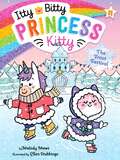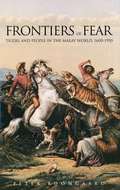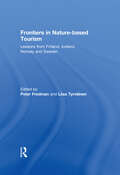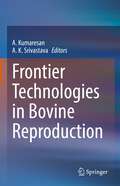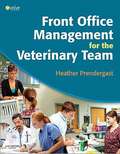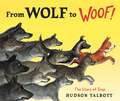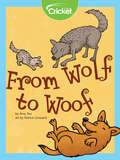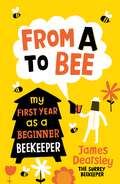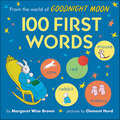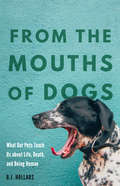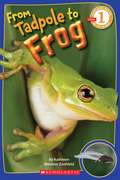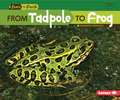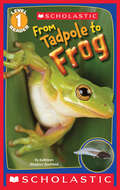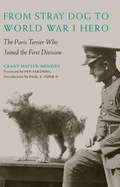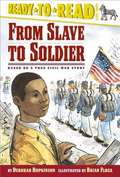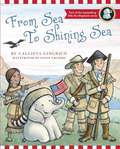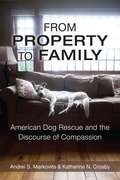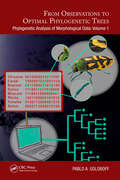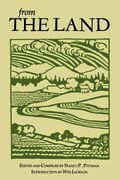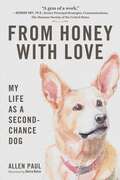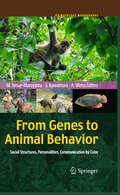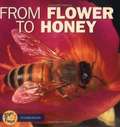- Table View
- List View
The Frost Festival (Itty Bitty Princess Kitty #11)
by Melody MewsItty is invited to judge the ice sculpture competition at the Frost Festival in this eleventh Itty Bitty Princess Kitty chapter book.The Frost Festival only occurs every five years in Lollyland. And not only has Itty been invited, she&’s been asked to judge the big ice sculpture competition! Itty and her best friend, Luna Unicorn, enjoy ice skating, sledding, and other snowy activities at the festival until it&’s time for Itty to judge. But before the competition can even begin, there&’s an argument between two ice sculptors. One is convinced that the other stole his carving tool! Can Itty find the missing ice pick—and find a way to settle the argument? With easy-to-read language and illustrations on every page, the Itty Bitty Princess Kitty chapter books are perfect for emerging readers.
Frontiers of Fear: Tigers and People in the Malay World, 1600-1950
by Peter BoomgaardThis book is about the relation between humans and the three big cats of the Malay world: the tiger, the leopard, and the clouded leopard. Above all, however, it is about the tiger.It is difficult to be neutral about tigers. They seem to elicit either strongly positive or strongly negative sentiments, and it is even possible (and far from rare) that one person has both positive and negative feelings about tigers.
Frontiers in Nature-based Tourism: Lessons from Finland, Iceland, Norway and Sweden
by Peter Fredman Liisa TyrväinenNature has been a key attraction factor for tourism in the Nordic countries for decades. The demand for nature-based tourism has steadily grown and is one of the most rapidly expanding sectors within tourism across Europe and elsewhere. This demand has created opportunities for nature-based tourism to develop as an economic diversification tool within regions rich in natural amenities. But nature-based tourism is not only about tourism businesses and tourists visiting nature. The natural environment as a basis for tourism involves many challenges related to local communities, public access, nature protection and the management of natural resources.This book covers a broad set of topics in contemporary nature-based tourism from Finland, Iceland, Norway and Sweden. Areas discussed are innovation, fishing rights and supply of angling, recreation experience preferences, national park attractions, the cultural clash between established outdoor recreational use and new tourism activities, the Right of Public Access as opportunity and obstacle, preferences of tourism landscapes, controversies around wilderness development, management of hiking trails, eco-tourism certification, and financing of recreational infrastructure.This book was published as a special issue of the Scandinavian Journal of Hospitality and Tourism.
Frontier Technologies in Bovine Reproduction
by A. Kumaresan A. K. SrivastavaThis book details the frontier technologies in the area of bovine reproduction. It describes the importance and significance of different technologies for improving reproduction efficiency in bovines. The book delineates the advancements in the technologies that are currently in use for faster multiplication of elite germ plasm including multiple ovulation and embryo transfer, ovum-pick-up, in vitro fertilization and embryo production, and semen sexing. Other emerging technologies, having potential for improving reproductive efficiency in bovines, including stem cells are also discussed with special reference to spermatogonial stem cells. Simple but effective tools having a great scope for day-to-day application in bovine farms for effective reproductive management like ultrasonography and thermal imaging are also covered in this book. The chapters on sperm transcriptomics, proteomics, metabolomics provide current developments in these areas and use of integrated approach for identification of fertility biomarkers. The chapters also describe technological advancements for early pregnancy diagnosis and offspring sex pre-selection in bovines. Additionally, this book discusses different sperm selection procedures including application of nanotechnology to obtain superior spermatozoa for assisted reproduction. Futuristic technologies including genomic selection and transgenesis are also discussed in detail. Finally, the book also elucidates a comprehensive description of challenges perceived with bovine reproduction and how effectively these technologies can help in improving fertility in bovines.
Front Office Management for the Veterinary Team
by Heather PrendergastThe only book of its kind, Front Office Management for the Veterinary Team focuses on the day-to-day duties of the veterinary team. It offers a complete guide to scheduling appointments, billing and accounting, communicating effectively and compassionately with clients, managing medical records, budgeting, marketing your practice, managing inventory, using outside diagnostic laboratory services, and much more. Written by Heather Prendergast, RVT, CVPM, this manual simplifies essential tasks with step-by-step instructions! Exercises on the Evolve website offer additional practice with front office tasks. Interactive working forms give you experience completing sample checks, deposit slips, patient history forms, and incident reports. The latest information on electronic banking and tax forms ensures that you adhere to the most current financial guidelines. What Would You Do/Not Do boxes provide scenarios to expose you to real-life situations that occur in veterinary practice and guide you through to an appropriate resolution. Review questions test your understanding of concepts presented in each chapter. Practice Point boxes highlight practical information to remember while on the job. Veterinary Practice and the Law boxes provide essential information about laws that you must know in order to run an ethical practice and to protect the practice. Key terms and learning objectives guide you through study of the most important content.
From Wolf to Woof: The Story of Dogs
by Hudson Talbott"It's hard to imagine the child—story-lover or fact-lover, dog-lover or not—who would not be drawn in by this book."—The New York Times Book ReviewHow did dog become man&’s best friend? Dogs come in such a variety of shapes, sizes, and breeds, that it is hard to believe that they all have a common ancestor--the wolf! Hudson Talbott takes readers on a fascinating journey through history to see how wolves&’ relationships with humans sparked their development into the dogs we know and love today. Striking paintings, from an adorable wolf pup to a wide range of modern-day dog breeds, illustrate this insightful story of teamwork and friendship. Through the eyes of a prehistoric boy and a lone wolf pup, we see how the bond between our ancestors and these wild animals may have developed. Starting as enemies competing for food, the wolf and the boy realize that they&’ll eat better and be safer if they team up. Over time, others catch on, and as many of the wolves become more domesticated, the humans breed them for skills like hunting, herding, pulling, and rescuing. And today, there are more breeds of dog than of any other animal, all thanks to this relationship that started so long ago.
From Wolf to Woof
by Amy TaoAll of our pet dogs today have evolved from wild wolves. Humans began to tame wolves and then select their friendliest pups for keeping. Gradually, people learned how choose some dogs and breed them to do different jobs.
From A to Bee: My First Year as a Beginner Beekeeper
by James DearsleyJames Dearsley’s wife thought he had lost his mind when he announced his intention to become a beekeeper. Like many interested in self-sufficiency, he loved gardening and growing vegetables and he wanted to teach his little boy where honey came from, so he set himself a goal: to get, in a year’s time, just one jar of honey.
From A to Bee: My First Year as a Beginner Beekeeper
by James DearsleyJames Dearsley’s wife thought he had lost his mind when he announced his intention to become a beekeeper. Like many interested in self-sufficiency, he loved gardening and growing vegetables and he wanted to teach his little boy where honey came from, so he set himself a goal: to get, in a year’s time, just one jar of honey.
From the World of Goodnight Moon: 100 First Words
by Margaret Wise BrownA delightful word book illustrated with familiar and comforting art from the world of Goodnight Moon. Sturdy board pages with 100 words organized into categories such as Animals, Colors, Toys, and Bedtime makes this word book just right for helping babies and toddlers identify words they’re beginning to learn.There’s no better way to get kids pointing, naming, and talking than with the iconic words and illustrations readers will recognize from Margaret Wise Brown’s and Clement Hurd’s beloved classics Goodnight Moon and My World.Perfect for tiny hands and growing minds, this word book is a great addition to every child’s first bookshelf.
From the Seashore to the Seafloor: An Illustrated Tour of Sandy Beaches, Kelp Forests, Coral Reefs, and Life in the Ocean's Depths
by Janet VoightAn octopus expert and celebrated artist offer a deep dive to meet the enchanting inhabitants of the world’s marine ecosystems. Have you ever walked along the beach and wondered what kind of creatures can be found beneath the waves? Have you pictured what it would be like to see the ocean not from the shore but from its depths? These questions drive Janet Voight, an expert on mollusks who has explored the seas in the submersible Alvin that can dive some 14,000 feet below the water’s surface. In this book, she partners with artist Peggy Macnamara to invite readers to share her undersea journeys of discovery. With accessible scientific descriptions, Voight introduces the animals that inhabit rocky and sandy shores, explains the fragility of coral reefs, and honors the extraordinary creatures that must search for food in the ocean’s depths, where light and heat are rare. These fascinating insights are accompanied by Macnamara’s stunning watercolors, which illuminate these ecosystems and other scenes from Voight’s research. Together, they show connections between life at every depth—and warn of the threats these beguiling places and their eccentric denizens face.
From the Mouths of Dogs: What Our Pets Teach Us about Life, Death, and Being Human
by B. J. HollarsWhat is it that dogs have done to earn the title of “man’s best friend”? And more broadly, how have all of our furry, feathered, and four-legged brethren managed to enrich our lives? Why do we love them? What can we learn from them? And why is it so difficult to say good-bye? Join B.J. Hollars as he attempts to find out—beginning with an ancient dog cemetery in Ashkelon, Israel, and moving to the present day. <p><p> Hollars’s firsthand reports recount a range of stories: the arduous existence of a shelter officer, a woman’s relentless attempt to found a senior-dog adoption facility, a family’s struggle to create a one-of-a-kind orthotic for its bulldog, and the particular bond between a blind woman and her Seeing Eye dog. The book culminates with Hollars’s own cross-country journey to Hartsdale Pet Cemetery—the country’s largest and oldest pet cemetery—to begin the long-overdue process of laying his own childhood dog to rest. <p> Through these stories, Hollars reveals much about our pets but even more about the humans who share their lives, providing a much-needed reminder that the world would be a better place if we took a few cues from man’s best friends.
From Tadpole To Frog (Scholastic Reader Level 1 Ser.)
by Kathleen Weidner ZoehfeldRelaunch of the Scholastic Science Readers with brand new covers, photographs, and interior designs. Watch a tiny tadpole grow into an adult frog in this book full of facts and photographs. Learn what tadpoles eat, how they survive, and how they transform into frogs.
From Tadpole to Frog (Let's Read And Find Out)
by Wendy PfefferThis book explains the life cycle of a frog right from eggs to tadpoles to frogs.
From Tadpole to Frog (Start to Finish, Second Ser.)
by Shannon ZemlickaFollows the development of a frog from the egg its mother lays, to the tadpole that swims underwater, to the fully developed frog that hops on land. Lexile Measure: 420L
From Tadpole to Frog (Scholastic Reader, Level 1)
by Kathleen Weidner ZoehfeldHow DOES a tadpole become a frog?Watch a tiny tadpole grow into an adult frog in this book full of facts and photographs. Learn what tadpoles eat, how they survive, and how they transform into frogs.
From Stray Dog to World War I Hero: The Paris Terrier Who Joined the First Division
by Grant Hayter-Menzies Pen Farthing Paul E. Funk IIOn the streets of Paris one day in July 1918, an American doughboy, Sgt. Jimmy Donovan, befriended a stray dog that he named Rags. No longer an unwanted street mutt, Rags became the mascot to the entire First Division of the American Expeditionary Force and a friend to the American troops who had crossed the Atlantic to fight. Rags was more than a scruffy face and a wagging tail, however. The little terrier mix was with the division at the crucial battle of Soissons, at the Saint-Mihiel offensive, and finally in the blood-and-mud bath of the Meuse-Argonne, during which he and his guardian were wounded. Despite being surrounded by distraction and danger, Rags learned to carry messages through gunfire, locate broken communications wire for the Signal Corps to repair, and alert soldiers to incoming shells, saving the lives of hundreds of American soldiers. Through it all, he brought inspiration to men with little to hope for, especially in the bitter last days of the war. <p><p> From Stray Dog to World War I Hero covers Rags’s entire life story, from the bomb-filled years of war through his secret journey to the United States that began his second life, one just as filled with drama and heartache. In years of peace, Rags served as a reminder to human survivors of what held men together when pushed past their limits by the horrors of battle.Watch a book trailer.
From Slave to Soldier: Based on a True Civil War Story
by Deborah HopkinsonDuring the Civil War, African Americans struggled to be accepted as soldiers. From Slave to Soldier is fiction, but it is based on the true story of a boy named John McCline, who was enslaved on a Tennessee plantation until the age of eleven. One day in 1862 he ran away and joined a passing group of Union soldiers in the Thirteenth Michigan Infantry Regiment. Young John became a mule-team driver's helper in the Union army until the end of the Civil War. After the war John went to school and worked in hotels. In 1892 he went to work for the family of Herbert Hagerman and moved to Santa Fe, New Mexico. Around 1930 McCline showed his handwritten memoir of his early years to Hagerman, who typed it and wrote an introduction. Although it did not become a book during McCline's life, the typed copy was kept in his family and published by the University of Tennessee Press in 1998. McCline married at age eighty-six and died in 1948, when he was about ninety-five. This story is based on McCline's memory of driving a wagon alone to bring supplies to the battlefield. Years after his war experiences McCline remembered the names of all his mules, and they have not been changed in this story. Many blacks in the Union army were not treated as kindly as young McCline was. But John McCline's incredible memory for detail helps us better understand what life was like for one boy who went from being "a slave to a soldier."
From Sea to Shining Sea
by Callista Gingrich Susan ArcieroEllis the Elephant is back and ready for another adventure in American history! In From Sea to Shining Sea, the fourth installment of Callista Gingrich’s New York Times bestselling series, Ellis explores the early years of the United States and heads west into uncharted territory with Lewis and Clark.In previous books, Sweet Land of Liberty, Land of the Pilgrims’ Pride, and Yankee Doodle Dandy, Ellis learned about pivotal moments that have shaped America. Now, in From Sea to Shining Sea, America’s favorite time-traveling pachyderm discovers a new and growing nation along with George Washington, Thomas Jefferson, Lewis and Clark, Sacagawea and others.Authored by Callista Gingrich and illustrated by Susan Arciero, From Sea to Shining Sea will delight those who want to know how brave Americans forged a growing nation and spread freedom from coast to coast.
From Property To Family: American Dog Rescue And The Discourse Of Compassion
by Andrei S. Markovits Katherine N. CrosbyIn the wake of the considerable cultural changes and social shifts that the United States and all advanced industrial democracies have experienced since the late 1960s and early 1970s, social discourse around the disempowered has changed in demonstrable ways. In From Property to Family: American Dog Rescue and the Discourse of Compassion, Andrei Markovits and Katherine Crosby describe a "discourse of compassion" that actually alters the way we treat persons and ideas once scorned by the social mainstream. This "culture turn" has also affected our treatment of animals inaugurating an accompanying "animal turn". In the case of dogs, this shift has increasingly transformed the discursive category of the animal from human companion to human family member. One of the new institutions created by this attitudinal and behavioral change towards dogs has been the breed specific canine rescue organization, examples of which have arisen all over the United States beginning in the early 1980s and massively proliferating in the 1990s and subsequent years. While the growing scholarship on the changed dimension of the human-animal relationship attests to its social, political, moral and intellectual salience to our contemporary world, the work presented in Markovits and Crosby's book constitutes the first academic research on the particularly important institution of breed specific dog rescue.
From Observations to Optimal Phylogenetic Trees: Phylogenetic Analysis of Morphological Data: Volume 1 (Species and Systematics)
by Pablo A. GoloboffTaxonomists specializing in different groups once based phylogenetic analysis only on morphological data; molecular data was used more rarely. Although molecular systematics is routine today, the use of morphological data continues to be important, especially for phylogenetic placement of many taxa known only from fossils and rare or difficult to collect species. In addition, morphological analyses help identify potential biases in molecular analyses. And finally, scenarios with respect to morphology continue to motivate biologists: the beauty of a cheetah or a baobab does not lie in their DNA sequence, but instead on what they are and do! This book is an up-to-date revision of methods and principles of phylogenetic analysis of morphological data. It is also a general guide for using the computer program TNT in the analysis of such data. The book covers the main aspects of phylogenetic analysis and general methods to compare classifications derived from molecules and morphology. The basic aspects of molecular analysis are covered only as needed to highlight the differences with methods and assumptions for analysis of morphological datasets.
From The Land: Articles Compiled From The Land 1941-1954
by Wes Jackson Nancy PittmanBegun in 1941 as an outgrowth of Friends of the Land, the journal The Land was an attempt by editor Russell Lord to counteract -- through education, information, and inspiration -- the rampant abuse of soil, water, trees and rivers. But for all its seriousness of mission, The Land was a stimulating mix of fact and charm. It included literature, philosophy, art, and the practical observations of farmers and conservation workers, to encourage small farmers to understand and apply conservation principles to their lands. This anthology, a fascinating mosaic, compiled from the 13 years of The Land tells in fiction, non-fiction, poetry, and philosophy the story of how we changed from a nation of small farms to the agribusiness we have today. Among the 40 authors included are conservation and literary giants such as Aldo Leopold, E. B.White, Louis Bromfield, Paul Sears, Allan Patton and Wallace Stegner.
From Honey With Love: My Life as a Second-Chance Dog
by Allen PaulIn From Honey With Love, Honey—a swamp dog living in the wild—tells her own harrowing story in a charming southern voice. <p><p>Barely a year old, her high-stakes drama begins when she gets trapped and nearly shot. Convinced that she’s a coyote or a “ditch dog,” trappers want to wipe out her breed, perhaps the oldest in North America. But Honey gets rescued by Miss Jane and taken to Banbury Cross Farm, where she rescues and raises Honey’s breed—the Carolina Dog or American Dingo. <p><p>At the farm, Honey quickly bonds with Mr. Billy, the Field Master for fox hunters, and Ace, the farm manager. They quickly bond as a pack, like the one Honey left in the swamp. Honey’s quickness causes Ace, Miss Jane, and Mr. Billy to train her to become an agility champion. How she runs the race of her life, and how the killers in the swamp get caught, lives in legend. <p><p>Along the way, Honey learns a lesson she’ll never forget: the strength of the wolf is the pack, and the strength of the pack is the wolf.
From Genes to Animal Behavior
by Alexander Weiss Shoji Kawamura Miho Inoue-MurayamaThe biological and genetic bases of behavioral diversity have long been topics of study within many disciplines, including evolutionary biology, genetics, ethology, sociobiology, and comparative psychology, but only relatively recently have attempts been made to bring these different approaches together. This volume covers a wide range of interdisciplinary research which uses some of the newest and most promising methods and technologies. Presented here is an overview of findings in the ongoing search for the ultimate causes of behavior in several different species, including primates, dogs, rodents, birds, and fish. Divided into five parts, the work describes research on sexual and kin selection, personality and temperament, molecular genetics of personality, color vision and body coloration, and the neurological underpinnings of complex behaviors. Valuable for researchers as well as graduate students in a wide range of fields from neuroscience to ecology, the book is also useful to those seeking to move beyond the boundaries of their own discipline and to expand their knowledge.
From Flower to Honey (Start to Finish)
by Robin NelsonSTART TO FINISH. HOW IS HONEY MADE? 1 Flowers open. 2 Bees fly to the flowers. 3 Bees drink nectar. What happens next? Read this book to find out!
